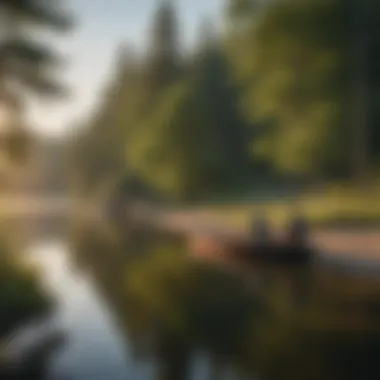Exploring Land Between the Lakes: Ecology and Recreation


Intro
Land Between the Lakes National Recreation Area is a unique place that deserves attention for its ecological and recreational significance. This region sits between Kentucky Lake and Lake Barkley in the states of Kentucky and Tennessee. It is host to a diverse set of ecosystems including forests, wetlands, and open fields. The area is not only a habitat for various species but also a popular destination for outdoor activities.
Understanding the ecological and recreational value of this area requires a look into how we manage its resources. Sustainable practices can enhance its biodiversity while promoting visitor engagement. This dynamic interplay between ecology and recreation influences the overall health of the environment and experiences offered to visitors.
Overview of Forestry Practices
Forestry practices are crucial for maintaining the ecological balance within Land Between the Lakes. The forests play a significant role in carbon sequestration, habitat protection, and water quality management.
Importance of Foresting
Forests provide numerous benefits that extend far beyond recreational opportunities. They help in soil erosion control, flood prevention, and act as a natural filter for water. Thuy trees, oak, and hickory are just some of the species found here. Proper forest management ensures that these ecosystems remain resilient.
Types of Forestry Practices
Different types of forestry practices are applied in Land Between the Lakes to maintain its health and productivity. Some key methods include:
- Selective Logging: This practice involves harvesting specific trees while maintaining the integrity of the surrounding ecosystem.
- Reforestation: Planting new trees to replace those that have been removed. This helps in sustaining the forest cover.
- Thinning: Reducing tree density to allow for better growth of remaining trees, enhancing biodiversity.
Best Practices for Sustainable Woodland Stewardship
Sustainable woodland stewardship involves managing forest resources responsibly. It ensures that current and future generations can enjoy the benefits that forests provide.
Principles of Sustainable Forestry
Some core principles guide sustainable forestry practices:
- Ecosystem Management: Prioritizing the health of the entire ecosystem over individual tree species.
- Community Involvement: Engaging local communities in forestry decisions, ensuring their needs are met while protecting the environment.
- Continuous Learning: Adapting forestry practices based on new research and technological advancements.
Techniques for Land Management
Effective land management techniques are essential for preserving the natural beauty and biodiversity of the region. These techniques may include:
- Controlled Burns: Managing underbrush to prevent larger wildfires while promoting healthy growth of certain species.
- Habitat Restoration: Repairing damaged ecosystems to bring back lost biodiversity.
Innovative Techniques in Forestry
In recent years, innovative techniques have changed forestry practices significantly. The aim is not only to enhance productivity but also to ensure sustainability in operations.
Latest Technological Advancements
Technological tools play a crucial role in modern forestry practices. These include:
- Geographic Information Systems (GIS): Used for mapping and analyzing forest resources.
- Drones: Provide aerial views for monitoring and assessing forest health.
Integrating Traditional Knowledge with Modern Science
Combining traditional ecological knowledge with modern scientific practices enriches forestry management. Local communities have long managed these ecosystems efficiently. Their insights combined with new research methods lead to more effective, culturally respectful management strategies.
"The effective management of forests is not just about cutting trees; it’s about preserving the future of ecosystems and the livelihoods they support."
Engagement with local stewardship practices can illustrate this blend of past and present methodologies, making the Land Between the Lakes a model for holistic forest management.
Prolusion to Land Between the Lakes
The Land Between the Lakes National Recreation Area (LBL) stands as a significant resource for ecological study and outdoor recreation. Spanning across over 170,000 acres in Kentucky and Tennessee, it serves as a unique meeting point for diverse ecosystems and recreational activities. Understanding this area is crucial yet complex; it not only offers outdoor adventure but also provides insights into environmental management, conservation, and biodiversity. The discussion around LBL highlights the interactions between human activities and natural landscapes, emphasizing a balance that is vital for sustainability.


Geographical Overview
Geographically, Land Between the Lakes is strategically positioned between Kentucky Lake and Lake Barkley. This region is characterized by rolling hills, forested areas, and open fields. It lies within the transition zone between the eastern deciduous forests and western prairies, creating a rich tapestry of habitats. The dominant topography includes valleys, ridges, and waterways that contribute to the area's ecological diversity.
Major waterways include the Tennessee River and the Cumberland River. Both drainages play a critical role in supporting various wildlife and plant species. Lakes and wetlands within the recreation area offer unique excursions into serene environments that attract numerous visitors every year. The geography supports various ecosystems, from floodplain forests to upland hardwoods, making it a prime study area for ecologists and conservationists.
Historical Context
The historical significance of Land Between the Lakes is profound. Established in 1963, it was engineered for multiple uses, combining recreation with conservation. The area was once populated by towns which were flooded to create the lakes. This history creates a unique backdrop for understanding both human and natural interactions through time.
The formation of these lakes was part of a larger plan of hydroelectric power generation and flood control. However, this decision came with consequences for the indigenous wildlife and habitats. Since then, a concerted effort has been made to restore and maintain the ecological balance of this area, focusing on biodiversity management and public access while respecting the historical context of the land.
Understanding these elements enhances the appreciation for LBL and sheds light on its significance for modern conservation and recreation efforts.
Ecological Significance
The ecological significance of Land Between the Lakes National Recreation Area is multifaceted, affecting not only local biodiversity but also broader environmental health. This area serves as a crucial habitat for various species, while also playing a key role in regional ecological balance. Understanding these dynamics is essential for both conservation efforts and sustainable recreation management.
Biodiversity of Flora and Fauna
The diversity of plant and animal life in Land Between the Lakes is striking. Over 1,300 plant species thrive here, ranging from towering oaks to delicate wildflowers. This variety supports a rich tapestry of life, including about 40 species of mammals, 200 species of birds, and numerous amphibians and reptiles. This biodiversity illustrates the area’s role as a refuge for wildlife and underscores its significance in maintaining ecological balance.
The wetlands, forests, and open fields provide different niches for various species. For example, the forests primarily host species like white-tailed deer and various songbirds, while the wetlands are critical for migratory waterfowl. Each ecosystem contributes uniquely to the overall health of the area.
Unique Ecosystems
Land Between the Lakes is characterized by its unique ecosystems, which include deciduous forests, wetlands, and open grasslands. These environments have evolved over millennia, creating special conditions that support both flora and fauna adapted to these areas. The complexity of these ecosystems not only enhances biodiversity but also influences hydrological cycles and soil health.
One significant ecosystem to note is the extensive network of water bodies. The lakes formed by the Tennessee River and the land itself act as a natural barrier, enabling distinct ecological zones. The interactions among these zones, including the influence of seasonal changes, contribute to the rich diversity found here. Additionally, these ecosystems demonstrate resilience; however, they need protection from external pressures such as development and invasive species.
Endangered Species and Conservation Efforts
Conservation efforts in Land Between the Lakes focus on protecting endangered species while maintaining a healthy ecosystem. Species such as the Indiana bat and the Tri-colored bat are particularly vulnerable. The area provides critical habitat that supports their survival, making conservation efforts here essential.
Management strategies include habitat restoration and public education. Collaborations with local organizations and stakeholders enhance the effectiveness of these efforts. Visitors are often engaged through programs that promote awareness about conservation practices and the importance of protecting endangered species.
"Protecting this national treasure not only preserves its beauty but also ensures the survival of numerous species that depend on it."
The ongoing commitment to conservation is vital for sustaining the ecological integrity of Land Between the Lakes. Each effort helps ensure that this area remains a thriving ecosystem for future generations while providing valuable recreational opportunities.
Recreational Opportunities
Recreational opportunities within Land Between the Lakes National Recreation Area are fundamental to understanding its overall value. The vast landscape offers a variety of activities that cater to different interests, fostering a connection between visitors and the natural world. This area promotes not just recreation for enjoyment but also encourages an appreciation for conservation and the ecological significance of the land. The benefits of these recreational options are numerous: they enhance physical well-being, offer mental rejuvenation, and provide avenues for educational experiences around nature and biodiversity.
Types of Activities Available
Hiking
Hiking holds a paramount place among the activities available at Land Between the Lakes. The extensive trail system winds through forests, along lakeshores, and across hills, providing hikers an immersive experience. This activity is a popular choice mainly because it allows individuals to engage directly with the ecosystem, offering benefits to both physical fitness and mental clarity.
A notable feature of hiking here is the diversity of trails, suitable for various skill levels, from easy walks to challenging routes. This inclusivity allows more visitors to explore the area. However, hikers should be mindful of their impact on the environment; staying on designated paths helps protect fragile ecosystems.
Fishing
Fishing is another significant recreational activity at Land Between the Lakes. With its vast freshwater bodies, the area provides ample opportunities for anglers. Whether it's casting from the shore or fishing from a boat, this activity fosters a profound appreciation for aquatic life and the health of water ecosystems.
The region is home to numerous species such as bass and crappie, making it attractive to both novice and experienced anglers. Still, environmental stewardship is essential; fishermen must adhere to local regulations to ensure sustainability and maintain fish populations for future generations.
Camping


Camping at Land Between the Lakes offers a chance for deeper immersion in the natural surroundings. With designated campgrounds, it provides facilities and a secure base for those seeking extended time outdoors. Camping encourages a greater appreciation for natural rhythms, from morning dew to nightly starry skies.
A unique feature of camping here is the chance for night-time observations of wildlife, a distinctive aspect that many campgrounds lack. On the other hand, campers must prepare diligently, as weather can change and camping requires a commitment to leave no trace. Balancing comfort and nature plays a critical role in enhancing the camping experience.
Facilities and Amenities
Land Between the Lakes is equipped with various facilities and amenities to enhance the visitor experience. These include well-maintained restrooms, picnic areas, and information centers where visitors can gather valuable insights about the region.
Moreover, interpretive programs are often available, aimed at educating visitors about the ecological significance of the area.
"The recreation area not only serves as a playground for outdoor enthusiasts but also a classroom for ecological education."
Facilities not only improve convenience but also promote responsible use of natural resources. As tourism grows, ongoing efforts to maintain and improve these amenities are essential for preserving the area’s integrity.
Visitor Engagement
Visitor engagement is a crucial component of the Land Between the Lakes National Recreation Area. It serves multiple purposes—enhancing the visitor experience, promoting conservation awareness, and fostering community relationships. Engaging visitors effectively leads to a deeper understanding of the ecological and recreational value of the area.
Educational Programs and Tours
Educational programs and guided tours are essential for improving visitor engagement. These initiatives provide opportunities for individuals to learn about the unique ecosystems and biodiversity of the region. Such interactions can include workshops on sustainable practices, interactive nature walks, and presentations given by local experts. Visitors gain insights on how to protect and enjoy natural resources responsibly.
The benefits of these programs are numerous:
- Knowledge Dissemination: They impart important information about wildlife, plants, and habitats present in the area.
- Awareness: Participants become more aware of environmental issues, which can lead to a stronger commitment to conservation.
- Enhanced Experience: Engaging with knowledgeable guides enriches the experience, making it more memorable.
As a result, these educational efforts not only inform but also inspire visitors to become stewards of the environment.
Community Involvement
Community involvement amplifies the impact of visitor engagement initiatives. Locals play a vital role in hosting events, volunteering for conservation projects, and participating in educational outreach.
The involvement of community members can strengthen the connections between the park and those who live nearby. Engaging citizens leads to a variety of benefits, such as:
- Local Knowledge: Residents often possess invaluable knowledge about the history, culture, and ecology of the area. Their perspectives can enhance visitor experiences.
- Shared Responsibility: When communities are involved, there is a shared sense of responsibility for the preservation and enjoyment of the area.
- Support for Initiatives: Community backing can lead to more effective management practices, as well as a robust network of support for conservation endeavors.
Overall, community involvement creates a sense of ownership among locals, fostering pride and dedication to the sustainability of the Land Between the Lakes National Recreation Area.
"Visitor engagement is not just about attracting people; it's about creating informed advocates for our natural spaces."
Through both educational programs and community involvement, the Land Between the Lakes demonstrates a commitment to connecting visitors with the ecological and recreational treasures it offers.
Environmental Management Practices
Environmental management practices are crucial for maintaining the integrity of the Land Between the Lakes National Recreation Area. These practices ensure that natural resources are used sustainably and that the ecosystems within the area are preserved for future generations. Sustainable management not only supports biodiversity, but it also enhances recreational opportunities, making the area a valuable resource for visitors and local communities alike.
Sustainable Forestry Practices
Sustainable forestry practices within the recreation area focus on the careful management of timber resources to minimize ecological impact. The area employs selective logging techniques and reforestation efforts which aim to maintain the health of forest ecosystems. This balanced approach safeguards soil quality and water resources while allowing timber harvesting to occur in a controlled manner. By prioritizing diversity in tree species and age structure, the management practices contribute to a resilient forest ecosystem.
Water Resource Management
Water resource management is another critical component of environmental strategies at Land Between the Lakes. The area features several lakes and waterways that require careful monitoring and management to ensure purity and usability. Efforts include implementing buffer zones around water bodies and controlling runoff from agricultural areas. These actions help prevent nutrient and sediment loading in lakes, supporting aquatic life and recreational fishing. Furthermore, regular assessment of water quality contributes to informed decision-making regarding conservation efforts.
Wildlife Habitat Preservation
Preserving wildlife habitats is essential for maintaining the biodiversity that characterizes the recreation area. Various initiatives are in place to protect critical habitats from development and invasive species. These efforts focus on the management of native vegetation and the restoration of degraded areas. Protecting habitats promotes healthy populations of both flora and fauna, directly supporting the ecological balance of the region. Through these practices, Land Between the Lakes continues to serve as a sanctuary for countless species, including those that are threatened or endangered.
"Effective environmental management not only conserves biodiversity but also enriches the recreational experiences available at Land Between the Lakes."


In summary, the environmental management practices implemented at Land Between the Lakes are vital for ensuring the long-term health of its ecosystems. Sustainable forestry, diligent water resource management, and wildlife habitat preservation work in tandem to protect this unique area while supporting its recreational value.
Challenges Facing the Area
The challenges confronting the Land Between the Lakes National Recreation Area are multifaceted and merit careful consideration. This section aims to outline significant environmental threats as well as management conflicts that complicate the area's sustainable development and conservation efforts. Understanding these issues is essential for effective environmental stewardship, ensuring balanced recreational use, and promoting long-term ecological health.
Environmental Threats
Land Between the Lakes is not immune to various environmental threats that pose risks to its delicate ecosystems. Some of these threats include:
- Invasive Species: Non-native flora and fauna often disrupt local ecosystems. Species such as Zebra Mussels and Japanese Knotweed can outcompete indigenous species for resources. This results in reduced biodiversity and shifts in ecosystem functions.
- Pollution: Runoff from nearby agricultural areas has introduced harmful chemicals into waterways. These pollutants adversely affect water quality, impacting aquatic life and the broader food chain.
- Climate Change: Alterations in temperature and precipitation patterns threaten native species and habitats. Warmer temperatures can influence breeding cycles and migration patterns, potentially displacing local wildlife.
- Urban Development: The encroachment of urban infrastructure diminishes natural habitats. Roads, housing, and other developments fragment ecosystems, making it difficult for wildlife to thrive.
Management Conflicts
Management conflicts arise when various stakeholders have differing objectives for the land's use. This tension can complicate conservation strategies and undermine efforts to preserve the area's ecological integrity. Key areas of conflict include:
- Recreational Use vs. Conservation: There is often a tension between the desire to increase recreational opportunities and the need to protect sensitive environments. For instance, the expansion of hiking trails may lead to habitat degradation if not managed properly.
- Resource Allocation: Limited funds and resources can lead to prioritizing certain projects over others. For example, budget constraints may limit wildlife management efforts, impacting species conservation.
- Stakeholder Interests: Local communities, businesses, and conservation groups may have conflicting interests regarding land use. Balancing these competing interests requires careful negotiation and stakeholder engagement.
"Effective land management in areas like Land Between the Lakes hinges on fostering cooperation among diverse user groups while prioritizing ecological health."
The Land Between the Lakes experience various challenges that necessitate ongoing dialogue, research, and adaptive management to ensure its ecological and recreational value is maintained for future generations.
Future Directions
The future of Land Between the Lakes National Recreation Area hinges on its ability to evolve, addressing both ecological challenges and visitor needs. Strategic planning is crucial for ensuring the area’s sustainability. Key aspects include innovative conservation strategies and improvements in visitor management. These directions will help maintain the integrity of the natural environment while enhancing the recreational experience.
Innovative Conservation Strategies
Innovative conservation strategies are essential for preserving the unique ecosystems found in Land Between the Lakes. With increasing pressure from climate change and human activities, it is important that these strategies are in place to protect biodiversity.
Adaptive Management: This approach includes regularly assessing and adjusting strategies based on ecological changes. By being flexible, managers can respond efficiently to emerging threats, thereby safeguarding wildlife habitats.
Community Involvement: Engaging local communities in conservation efforts fosters a sense of ownership and responsibility. Programs can include volunteer days for habitat restoration, where citizens partake in hands-on conservation work. Encouraging local stewardship can lead to more sustainable practices.
Research and Monitoring: Continuous ecological research is vital for understanding the dynamic environment. Implementing new technologies such as remote sensing allows for real-time monitoring of ecological changes. This data-driven approach helps in making informed decisions about resource management.
"Conservation must evolve with time to address the changing needs of ecosystems and communities."
Visitor Management Improvements
As the number of visitors to Land Between the Lakes continues to grow, effective visitor management becomes increasingly important. Improving visitor services while minimizing ecological impact can ensure a balanced approach between recreation and preservation.
Increased Infrastructure: Upgrading visitor facilities is a direct response to growing numbers. This may include more sustainable restroom facilities and improved parking areas. Well-planned infrastructure can enhance visitor experiences while protecting sensitive areas.
Education and Awareness: Providing visitors with information on environmental stewardship encourages responsible behaviors. Informational signage throughout the area can outline the importance of staying on designated paths, minimizing noise, and not disturbing wildlife.
Reservation Systems: Implementing a reservation system for high-traffic areas can help manage the number of visitors. This system ensures that the natural environment has time to recover from the pressure of foot traffic and allows for a more enjoyable experience for visitors.
Finale
The conclusion of this article serves as a crucial summation of the insights examined throughout. It reinforces the importance of the Land Between the Lakes National Recreation Area not just as a recreational hotspot but also as an ecological treasure.
Summary of Key Points
Throughout the article, key elements have emerged that underline the significance of this area.
- Ecological Richness: The incredible biodiversity present in both flora and fauna showcases the area’s unique ecosystems.
- Recreational Diversity: Visitors can partake in a wide range of activities, including hiking, camping, and fishing, making it an accessible destination for all.
- Conservation Efforts: Various initiatives aim at preserving endangered species and restoring habitats highlight a commitment to sustainability.
- Community Involvement: Engaging local communities fosters deeper connections to the land while promoting stewardship and education.
These points illustrate the interconnectivity of ecological health and recreational use, emphasizing that both aspects contribute positively to the overall value of the Land Between the Lakes.
Call to Action for Sustainable Practices
Addressing environmental concerns is essential to ensure the longevity of this area. Here are some actionable steps to promote sustainable practices:
- Participate in Cleanup Events: Join organized efforts to clean up litter and protect natural habitats.
- Advocate for Responsible Recreation: Educate others about the importance of Leave No Trace principles during outdoor activities.
- Support Conservation Programs: Engage in local conservation efforts through donations or volunteerism.
- Promote Environmental Education: Share knowledge about the area's ecological significance and encourage others to visit responsibly.















